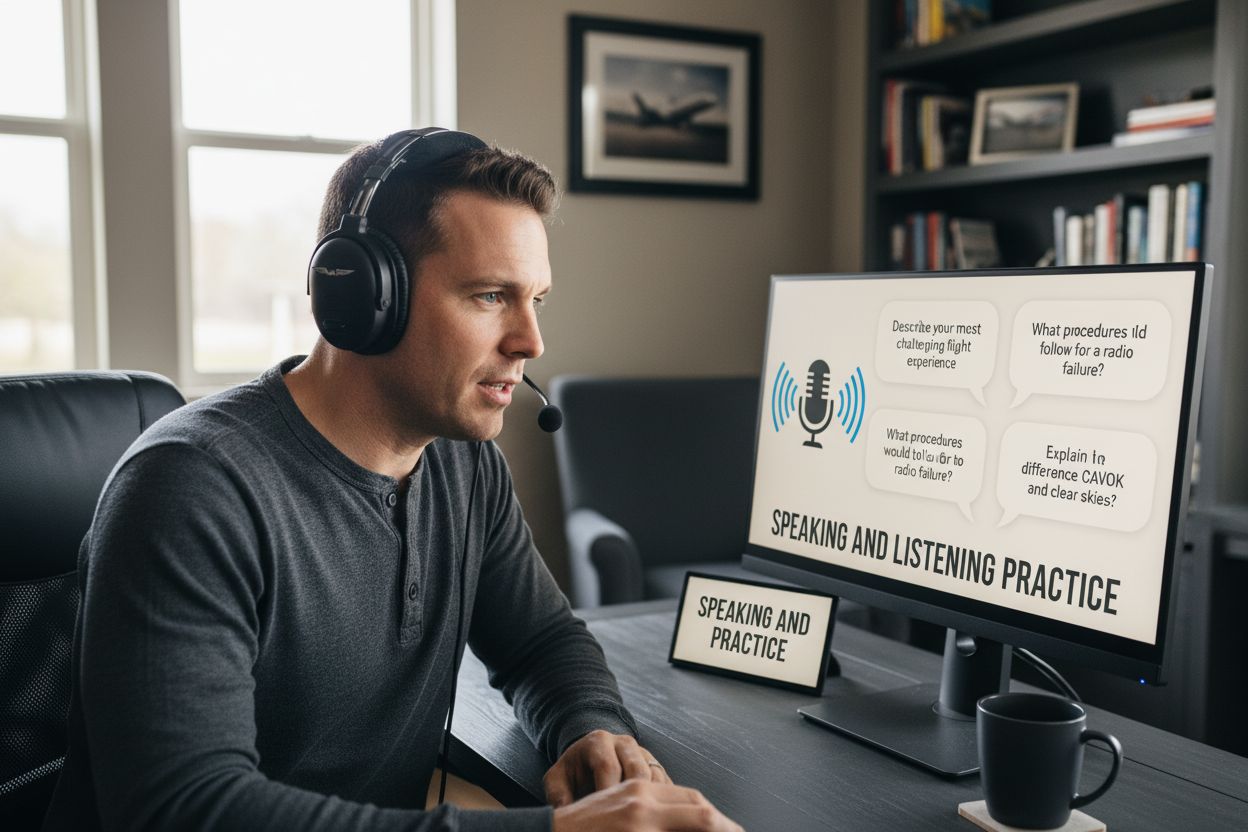Mastering aviation English is vital for professional pilots aiming to pass the ICAO Language Proficiency Test. Surprisingly, even native speakers can stumble because this exam is not about everyday conversation or clever wordplay. The real shock is that less than half of test-takers achieve Level 5 or above on their first attempt, which highlights just how demanding its standards are.
Table of Contents
-
Step 2: Research And Select An Accredited Online Test Provider
-
Step 3: Prepare Using Relevant Study Materials And Resources
-
Step 5: Schedule And Take The ICAO Language Proficiency Test
-
Step 6: Review Results And Plan For Any Necessary Improvements
Quick Summary
| Key Point | Explanation |
| 1. Assess your language skills thoroughly | Conduct a self-evaluation covering vocabulary, pronunciation, and technical communication to identify areas for improvement. |
| 2. Choose an accredited test provider | Ensure your selected online testing platform meets ICAO standards and specializes in aviation English to guarantee quality assessment. |
| 3. Utilise targeted study materials | Develop a structured study plan using aviation-specific resources to enhance communication skills relevant to your profession. |
| 4. Practice with sample tests | Engage in realistic practice scenarios to refine your speaking and listening abilities under exam conditions and improve confidence. |
| 5. Reflect and plan post-test improvements | After receiving your results, analyse your performance and create a structured plan to address any remaining weaknesses in your language skills. |
Step 1: Assess your current language skills
Successfully passing the ICAO Language Proficiency Test requires a strategic understanding of your current English communication abilities. This crucial first step involves a comprehensive self-evaluation that will determine your preparation strategy and highlight potential areas for improvement.
Language assessment begins with an honest, critical examination of your current English skills, specifically within the aviation context. Professional pilots need more than conversational English they require precise, clear communication skills that meet strict international standards. Take time to evaluate your vocabulary, pronunciation, listening comprehension, and ability to communicate complex technical information smoothly and accurately.
To conduct a thorough self-assessment, consider recording yourself performing typical aviation communication scenarios. Simulate radio communications, describe technical procedures, and explain emergency situations. Listen critically to your recordings, paying close attention to your pronunciation clarity, grammatical accuracy, and technical vocabulary usage. Identify specific challenges such as pronunciation of numerical sequences, complex aviation terminology, or maintaining composure during high-stress communication scenarios.
Learn more about aviation English proficiency standards to understand the precise linguistic requirements for professional pilots. Professional language assessment tools can provide structured insights into your current capabilities. Many online platforms offer diagnostic tests specifically designed for aviation professionals, which can help pinpoint exact strengths and weaknesses in your language skills.
Verification of your current skill level involves multiple approaches. Consider these key indicators of readiness:
-
Ability to understand and respond to standard aviation phraseology without hesitation
-
Clear pronunciation that allows immediate comprehension by air traffic controllers
-
Confidence in discussing technical procedures and potential emergency scenarios
-
Smooth grammatical communication without frequent pauses or corrections
Remember that language proficiency is not just about vocabulary but about creating clear, precise communication in high-stakes aviation environments. Your self-assessment provides the foundational roadmap for targeted language improvement.
Step 2: Research and select an accredited online test provider
Selecting the right online test provider for your ICAO Language Proficiency Test is a critical decision that will directly impact your preparation and ultimate success. This step requires careful research and strategic evaluation to ensure you choose a platform that meets international aviation standards and provides comprehensive testing resources.
Begin your research by focusing on providers with direct accreditation from ICAO recognized testing bodies. Not all online platforms are created equal, and aviation language testing demands exceptional precision and authenticity. Look for providers who specialize specifically in aviation English testing, as they will understand the unique communication requirements of professional pilots and air traffic controllers.
Explore comprehensive online pilot training resources to help refine your selection process. When evaluating potential testing providers, scrutinize their credentials meticulously. Verify their alignment with international language proficiency standards, specifically the ICAO Language Proficiency Rating Scale, which ranges from Level 1 (Pre-Elementary) to Level 6 (Expert).
Consider multiple factors during your selection process. Examine the provider’s testing methodology, which should simulate real-world aviation communication scenarios. The most effective platforms will offer interactive tests that assess your ability to communicate clearly under various professional contexts, including routine communications, complex technical descriptions, and potential emergency situations.
Critical verification points for selecting a reputable online test provider include:
-
Official recognition by international aviation authorities
-
Comprehensive test coverage across all ICAO language proficiency levels
-
Detailed performance feedback and diagnostic reports
-
Secure online testing environment
-
Options for multiple test attempts and skill improvement tracking
Be wary of providers offering unrealistically quick certifications or significantly lower prices. Quality aviation language testing requires sophisticated assessment tools and experienced evaluators. Your goal is not just passing a test but demonstrating genuine communication competence in high-stakes aviation environments. Take time to read reviews, request sample tests, and if possible, contact current or previous test-takers for their experiences and recommendations.
Step 3: Prepare using relevant study materials and resources
Preparing for the ICAO Language Proficiency Test demands a strategic approach to gathering and utilizing the most appropriate study materials. This critical step transforms your self-assessment insights into a targeted, comprehensive preparation strategy that addresses your specific language skill gaps.
Start by developing a structured study plan that focuses on aviation-specific communication skills. Professional language preparation goes far beyond standard English learning materials. You need resources that simulate real-world aviation communication scenarios, including radio communications, technical descriptions, and emergency situation dialogues. Seek out materials that specifically target aviation phraseology, technical vocabulary, and the precise communication standards required in professional pilot environments.
Discover advanced study techniques for aviation exams to enhance your preparation approach. Digital resources offer tremendous advantages for language preparation. Look for interactive online platforms that provide comprehensive listening exercises, pronunciation practice, and simulated communication scenarios. Video resources featuring actual pilot communications, air traffic control interactions, and professional aviation dialogue can provide invaluable insights into the nuanced communication requirements of the test.
Your study materials should comprehensively cover all aspects of the ICAO language proficiency assessment. This includes developing skills in:
-
Precise pronunciation and accent clarity
-
Technical vocabulary specific to aviation
-
Ability to communicate complex procedures
-
Understanding and responding to varied communication scenarios
-
Grammatical accuracy under pressure
Consider diversifying your study resources to create a robust preparation approach. Professional language training books, online video courses, native speaker conversation practice, and specialized aviation communication podcasts can all contribute to your skill development. Pay special attention to materials that offer diagnostic feedback, allowing you to track your progress and identify areas requiring additional focus.
Verify your preparation readiness by conducting mock tests that closely simulate the actual ICAO Language Proficiency Test environment. Time your practice sessions, record your communications, and critically evaluate your performance against professional aviation communication standards. Remember, successful preparation is about building confidence and demonstrating clear, precise communication skills in high-stakes professional scenarios.
Step 4: Practice speaking and listening with sample tests
Practicing with sample tests represents the most critical phase of your ICAO Language Proficiency Test preparation. This step transforms theoretical knowledge into practical communication skills, simulating the exact environment you will encounter during the actual examination.
Begin by selecting high-quality sample tests that precisely mirror the ICAO language assessment format. These practice materials should recreate authentic aviation communication scenarios, challenging you to demonstrate clear, precise technical communication under realistic conditions. Focus on tests that include diverse communication contexts such as routine flight operations, emergency procedures, navigation instructions, and technical problem-solving dialogues.
Learn advanced techniques for exam performance to enhance your test preparation strategy. When practicing, create a controlled environment that closely replicates the actual test conditions. Use noise-cancelling headphones, set strict time limits, and record your responses to enable later self-assessment. This approach allows you to evaluate your performance objectively, identifying pronunciation issues, grammatical inconsistencies, and communication clarity.
Effective sample test practice involves more than passive listening and responding. Develop a systematic approach to analyzing your performance after each practice session. Listen critically to your recordings, paying special attention to:
-
Pronunciation clarity and accent comprehensibility
-
Technical vocabulary accuracy
-
Grammatical structure and fluency
-
Response speed and confidence
-
Ability to handle complex or unexpected communication scenarios
Consider engaging with professional aviation language coaches or joining online study groups focused on ICAO language preparation. These resources can provide valuable external feedback and help you understand subtle communication nuances that might not be immediately apparent in self-assessment. Professional guidance can help refine your communication skills, ensuring you meet the stringent international standards required for aviation professionals.
Verify your readiness by consistently scoring within the required proficiency levels across multiple sample tests. Your goal is not just passing the test but demonstrating confident, precise communication that meets the highest international aviation standards. Regular, structured practice will transform your language skills from merely functional to professionally exceptional.

Step 5: Schedule and take the ICAO language proficiency test
Scheduling and completing your ICAO Language Proficiency Test represents the culmination of your extensive preparation journey. This final step requires meticulous planning, strategic preparation, and a calm, confident approach to demonstrate your professional communication skills.
Begin by thoroughly reviewing the specific scheduling requirements of your chosen testing provider. Confirm all documentation and identification requirements well in advance of your test date. Most providers mandate specific forms of professional identification, proof of aviation credentials, and potentially additional supporting documents. Prepare a comprehensive portfolio that includes your pilot license, passport, and any prerequisite certifications to ensure a smooth registration process.
Explore professional English phraseology examination guidelines to understand the nuanced communication expectations. When scheduling your test, select a time slot that aligns with your peak performance hours. Consider factors like personal energy levels, potential travel requirements, and any potential external distractions. Many candidates find morning sessions provide optimal mental clarity and reduced anxiety.
Prepare your test environment meticulously, whether you are taking an online or in-person examination. For digital tests, ensure a stable internet connection, quiet testing space, and all necessary technical equipment. Conduct a comprehensive technical check of your computer, microphone, and audio systems at least 24 hours before the test to prevent last-minute technical complications.
Below is a checklist table to help you verify your readiness before scheduling and taking your ICAO Language Proficiency Test.
| Verification Item | Description | Completed (Yes/No) |
| Documentation Prepared | Ensure pilot licence, passport, and required certificates are ready | |
| Internet and Technical Equipment Checked | Confirm computer, microphone, audio, and stable internet are functional | |
| Suitable Testing Environment Arranged | Quiet space secured, free of distractions and interruptions | |
| Review of Test Provider Requirements | All provider-specific requirements and instructions understood | |
| Practice of Key Terminology and Scenarios | Reviewed aviation communication phrases and emergency procedures | |
| Stress Management and Rest Planned | Practised relaxation techniques and scheduled adequate rest | |
| Time Slot Chosen for Peak Performance | Scheduled test at a personal optimal time for focus and alertness |
Critical preparation steps in the final days before your test include:
-
Reviewing key aviation communication terminology
-
Practicing relaxation and stress management techniques
-
Confirming all required identification documents
-
Getting adequate rest the night before the examination
-
Preparing professional attire that boosts confidence
During the test, maintain a professional demeanor and communicate with the same precision and clarity you would in an actual aviation environment. Listen carefully to instructions, ask for clarification if needed, and approach each communication scenario methodically. Your goal is not just to pass the test but to demonstrate the high-level communication skills essential for professional pilots.
Verify your test completion by carefully reviewing your performance, understanding your score report, and reflecting on areas of strength and potential future improvement. Remember, the ICAO Language Proficiency Test is more than an examination it is a critical validation of your professional communication capabilities.
Step 6: Review results and plan for any necessary improvements
Reviewing your ICAO Language Proficiency Test results is a critical reflection process that transforms test outcomes into actionable professional development strategies. This step is not merely about understanding your score but creating a comprehensive improvement plan that addresses specific communication challenges.
Begin by thoroughly analyzing your detailed score report, paying close attention to nuanced performance metrics. Each assessment provides granular insights into your language communication skills, highlighting specific areas of strength and potential development. Professional pilots must view this evaluation as an opportunity for continuous improvement, not just a pass or fail scenario.
Discover advanced aviation communication training resources to support your ongoing language skill enhancement. If you did not achieve the required proficiency level, develop a targeted remediation strategy that focuses on your specific communication challenges. This might involve specialized language coaching, additional aviation-specific communication workshops, or intensive pronunciation and technical vocabulary training.
Your improvement plan should be comprehensive and structured, addressing multiple dimensions of aviation language proficiency. Consider creating a detailed roadmap that breaks down complex communication skills into manageable, measurable objectives. This approach transforms potential disappointment into a strategic professional development opportunity.
Key components of an effective post-test improvement strategy include:
-
Identifying specific communication weaknesses revealed in the test
-
Setting clear, measurable language skill enhancement goals
-
Developing a consistent practice schedule
-
Seeking professional language coaching
-
Regularly recording and analyzing communication performance
Remember that language proficiency is a dynamic skill that requires consistent nurturing. Professional pilots must view communication abilities as a critical component of their overall aviation competence. Engage with aviation language communities, participate in professional forums, and seek opportunities to practice complex technical communication in diverse contexts.
Verify your improvement progress by periodically reassessing your language skills through mock tests, professional feedback, and self-evaluation. Your goal is not just meeting minimum standards but developing exceptional communication capabilities that distinguish you as a professional pilot. Approach each assessment as a stepping stone towards more refined, precise, and confident aviation communication.
Turn Your ICAO Exam Preparation into Real Success with VictorOne
You have put in the effort to assess your skills, practice with mock tests, and seek out the right resources for your ICAO Language Proficiency Test. Yet, the anxiety about meeting international standards or not finding accredited study materials can feel overwhelming. VictorOne’s Academy has helped hundreds of aviation professionals overcome these same barriers by providing EASA-approved online courses, up-to-date ICAO English exam preparations, and supportive tools tailored for ambitious pilots. Our learning platform addresses common challenges like unclear communication scenarios, lack of structured mock tests, and uncertainty about exam registration so you never have to prepare alone.

Why let hesitation slow your flying career? With VictorOne.eu, you get instant access to comprehensive pilot training, digital aviation materials, interactive question banks, and direct online exam scheduling. Master your ICAO test and start advancing your professional future today. Visit our Academy to unlock premium resources or head straight to VictorOne.eu to take the next step towards certification now.
Frequently Asked Questions
What is the ICAO Language Proficiency Test?
The ICAO Language Proficiency Test assesses the English communication skills of aviation professionals, ensuring that they can communicate effectively in high-stakes environments such as air traffic control and flight operations.
How can I assess my current English language skills for the ICAO test?
Begin with a self-evaluation focusing on your vocabulary, pronunciation, listening comprehension, and ability to convey complex technical information. Recording yourself in aviation-related scenarios can help identify areas for improvement.
What types of study materials are suitable for preparing for the ICAO Language Proficiency Test?
Look for aviation-specific resources that simulate real-world communication scenarios. This includes interactive online tests, specialised aviation phraseology, and practice exercises that cover pronunciation and technical vocabulary.
How should I practice speaking and listening skills before taking the ICAO test?
Utilise high-quality sample tests that mirror the ICAO assessment format. Practise in a controlled environment, record your responses, and critically evaluate your performance to identify areas for improvement.


